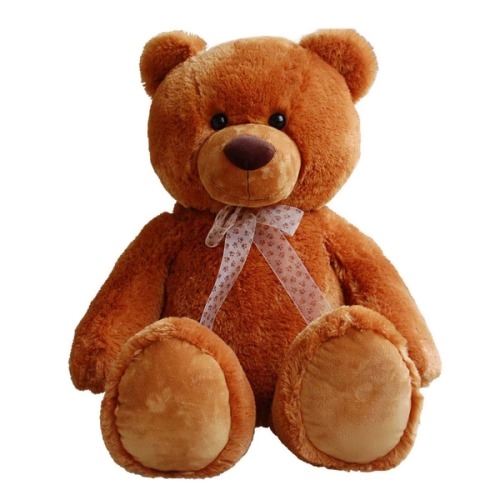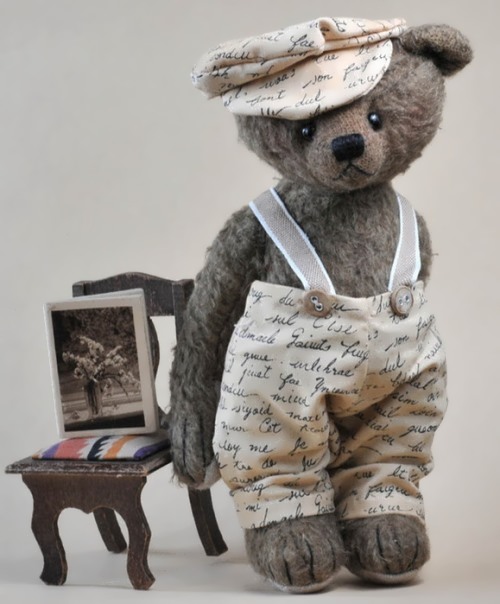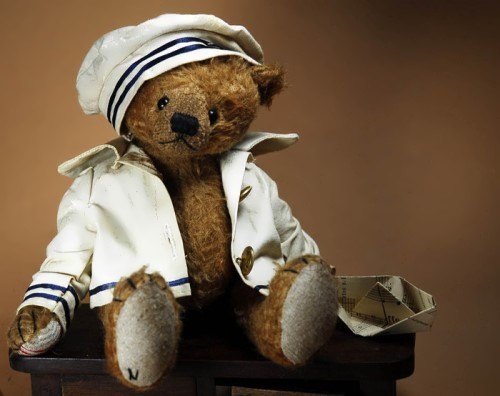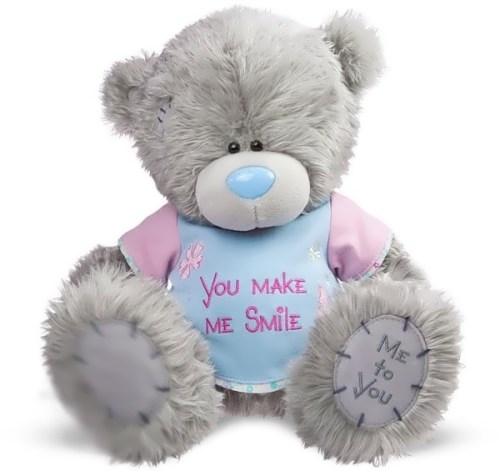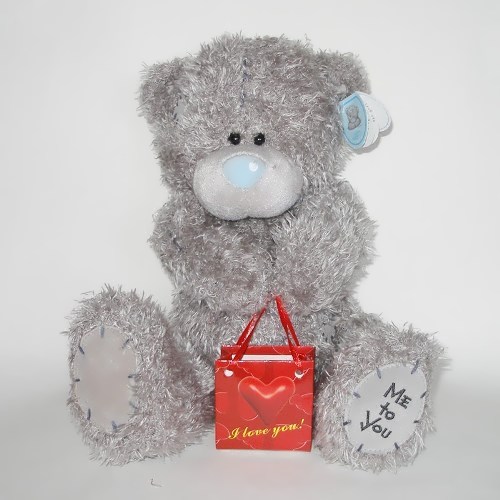- Подробности
-
37367
 |
||
| Прочитайте текст. Заполните пропуски в предложениях под номерами В4-В12 соответствующими формами слов, напечатанных заглавными буквами справа от каждого предложения. TEST 04 (part1) |
The world of Teddy Bears
|
B4 |
The story of teddy bears goes back to 1902, when Theodore Roosevelt was President of the United States. The press and the people fondly called him Teddy. |
GO |
|
B5 |
He did not like/ didn’t like the name, but accepted it. |
NOT LIKE |
|
B6 |
Once President Roosevelt was hunting in the forest. After several hours, he still hadn’t bagged anything. Then one of his aides discovered a lost bear cub and tied it to a tree — here was the President’s trophy for the day! |
HUNT |
|
B7 |
But Roosevelt could not/ couldn’t bring himself to shoot the cub, and ordered it to be set free. |
CANNOT |
|
B8 |
The next day newspapers were filled with cartoons depicting him with a bear. |
FILL |
|
B9 |
An idea came to the owners of a candy store in New York. |
OWNER |
|
B10 |
They made a little toy bear cub and put it in theirshop window with a notice saying ‘Teddy’s Bear’. The Bear was such a hit that they sent a bear to the White House, together with a request to use the President’s name for their stuffed bears. Roosevelt gladly gave his permission. |
THEY |
|
B11 |
Soon new toys became the most favourite companions |
FAVOURITE |
|
B12 |
of all American children. |
CHILD |
Интересно, а вы задумывались когда-нибудь, почему медведь, который в природе является одним из самых грозных хищников, превратился в самую любимую игрушку детей? Вряд ли найдется человек, у которого в детстве не было медвежонка, которого укладывали спать рядом с собой.

Алан Александр Милн, английский писатель и автор повестей о медвежонке Винни-Пухе, ответил на этот вопрос в шутливой форме:
«Is it Mr Edward Bear?» — Это Мистер Эдвард Медведь?
Дело в том, что «Teddy» — уменьшительно-ласкательная форма имен Эдвард, Эдмунд и Теодор.
В Оксфордском словаре английского языка (The Oxford English Dictionary) мы читаем следующее:
впервые словосочетание «teddy bear» зафиксировано в 1906г. и, как многие считают, это была аллюзия* на имя Теодора Рузвельта, президента США в 1901-1906гг., которого часто называли «Teddy Roosevelt».
* аллюзия — это художественный прием, когда автор сознательно намекает на общеизвестный литературный факт, историческое событие или даже известную личность.
Тогда возникает вопрос: почему президент Рузвельт ассоциируется с медведем?
Теодор Рузвельт увлекался охотой, в частности, охотой на медведей. В результате чего в январе 1906г. в газете Нью-Йорк Таймс появилось шутливое стихотворение о приключениях двух медведей, Teddy B и Teddy G, сопровождаемое карикатурами.
Вот его фрагмент:
The «Teddy» part is a name they found
On hat and tree and leggings round,
On belt and boot, and plates of tin,
And scraps of paper and biscuits thin,
And other things that hunters drop
When they chase a bear to a mountain top.

Оставим на время Америку и отправимся в Европу конца XIX века. И не просто в Европу, а в мастерскую Маргарет Штейфф, что находилась в Лейпциге. В 1897г. в каталоге игрушек мастерской Штейфф впервые появились плюшевые медвежата, которые умели двигать головой и лапами (медведи «roly—poly»). На Лейпцигской ярмарке необычные игрушки получили высокую награду, а в 1899г. М. Штейфф запатентовала игрушку.
Успех мишек был просто ошеломляющим, они продавались по всей Европе, а в 1903г. первая партия мишек отправилась за океан, в далекую Америку, где за ними прочно закрепилось название «teddy bear».
А потом «teddy bear» стало использоваться для описания внешности в значении «милый», «привлекательный», «вызывающий симпатию».
В 1961 г. вышел роман Джона Ле Карре «Звонок покойнику» (Сall for Dead), в котором можно найти следующее предложение «My darling teddy bear».
Вот такая интересная история у любимой нами с детства игрушки.
1) Преобразуйте слово, написанное заглавными буквами, так, чтобы оно грамматически соответствовало содержанию текста.
The World of Teddy Bears
The story of teddy bears ___ (GO) back to 1902, when Theodore Roosevelt was President of the United States.
2) Преобразуйте слово, написанное заглавными буквами, так, чтобы оно грамматически соответствовало содержанию текста.
The press and the people fondly called him Teddy. He ___ (NOT LIKE) the name, but accepted it.
3) Преобразуйте слово, написанное заглавными буквами, так, чтобы оно грамматически соответствовало содержанию текста.
Once President Roosevelt ___ (HUNT) in the forest.
4) Преобразуйте слово, написанное заглавными буквами, так, чтобы оно грамматически соответствовало содержанию текста.
After several hours, he still hadn’t bagged anything. Then one of his aides discovered a lost bear cub and tied it to a tree — here was the President’s trophy for the day! But Roosevelt ___ (CANNOT) bring himself to shoot the cub, and ordered it to be set free.
5) Преобразуйте слово, написанное заглавными буквами, так, чтобы оно грамматически соответствовало содержанию текста.
The next day newspapers ___ (FILL) with cartoons depicting him with a bear.
6) Преобразуйте слово, написанное заглавными буквами, так, чтобы оно грамматически соответствовало содержанию текста.
An idea came to the ___ (OWNER) of a candy store in New York.
7) Преобразуйте слово, написанное заглавными буквами, так, чтобы оно грамматически соответствовало содержанию текста.
They made a little toy bear cub and put it in ___ (THEY) shop window with a notice saying ‘Teddy’s Bear’. The Bear was such a hit that they sent a bear to the White House, together with a request to use the President’s name for their stuffed bears. Roosevelt gladly gave his permission.

Soon new toys became the ___ (FAVOURITE) companions…
9) Преобразуйте слово, написанное заглавными буквами, так, чтобы оно грамматически соответствовало содержанию текста.
… of all American ___ (CHILD).
10) Преобразуйте слово, написанное заглавными буквами, так, чтобы оно грамматически и лексически соответствовало содержанию текста.
Did You Know?
In spite of the ___ (ROMANTIC) reputation of the British, over 16 million Valentine cards are sent each year on February 14th. 39% of Valentine cards are sent by women and 61% by men.
11) Преобразуйте слово, написанное заглавными буквами, так, чтобы оно грамматически и лексически соответствовало содержанию текста.
___ (ORIGINAL), Valentine cards were only sent by men to women. They were all handmade and elaborately decorated.
12) Преобразуйте слово, написанное заглавными буквами, так, чтобы оно грамматически и лексически соответствовало содержанию текста.
The oldest ___ (EXIST) Valentine card can be found in the British Museum. It was sent in the year 1415.
13) Преобразуйте слово, написанное заглавными буквами, так, чтобы оно грамматически и лексически соответствовало содержанию текста.
St Valentine’s Day is now ___ (CELEBRATION) in many countries all over the world,…
14) Преобразуйте слово, написанное заглавными буквами, так, чтобы оно грамматически и лексически соответствовало содержанию текста.
… ___ (INCLUDE) Russia and China.
15) Преобразуйте слово, написанное заглавными буквами, так, чтобы оно грамматически и лексически соответствовало содержанию текста.
But in ___ (ATHEISM) China your flowers can be confiscated if the police see you in the street with a bouquet.
The World of Teddy Bears
Everyone knows Teddy Bear. But why he was called Teddy? Why not Harry or John or Jane?
The story goes back to 1902, when Theodore Roosevelt was President of the United States. The press and the people called him Teddy. He didn’t like the name, but accepted it. It made him seem more informal to the people he served. In November 1902 President Roosevelt decided to go out hunting for the day. After several hours, he still hadn’t bagged anything. Then one of his aides discovered a lost bear cub wandering through the woods. But Roosevelt couldn’t bring himself to shoot the defenceless cub. The newspapers were filled with cartoons depicting him with a bear. The story became fable.
Mr and Mrs Michtom, owners of a candy store in New York, saw the cartoon and made a little toy bear cub. They put it in their shop window with a copy of the cartoon, and a handwritten notice saying ‘Teddy’s Bear’. The toy was a hit. So the Michtoms designed and produced a bear to be presented to the White House, accompanying a request to use the President’s name for their bears. Roosevelt gladly gave his permission.
The Michtoms closed their candy store, and founded the Ideal Novelty and Toy Co — still one of the biggest toy firms in the world.
Meanwhile, in Germany, Richard Steiff was working in stuffed toy business. He often visited the Stuttgart Zoo to draw animals. In 1902 the Steiff firm made a prototype of a toy bear based on Richard’s designs. The toy first appeared in 1903 at the Spring Toy Fair at Leipzig. The legend says that an American toy buyer came up to Richard at the end of the fair and ordered 3000 bears for shipment to the US.
In the world began Teddy Bear- mania. Society ladies carried their teddies everywhere, and children had pictures with their favorite toys. Roosevelt adopted the bear cub as his mascot for a successful re-election campaign.
Over the years, the cuddly toy has taken many shapes and varieties.
Teddy became more popular thanks to the artist Mike Payne, who illustrated greeting cards under the name Miranda. One day, Mike came up with a story about Tatty Teddy Bear. The story began in the fall of 1987 in the English village of Sussex. There was an old ramshackle house, whose owners left it long ago. Unnecessary things were left in the garden. And there, in the middle of the pile, was a small Teddy Bear. He was forgotten, and seemed the loneliest bear in the world. Winter came. Because of snowfalls Teddy’s fur turned gray and little nose turned blue from the cold. In the spring, one little girl found the bear. Despite the fact that the bear was not new and covered with patches the girl still loved him more than her other toys.
This simple but touching story won the hearts of all the children, and Payne’s bear gained worldwide popularity.
British company Carte Blanche began to produce bear under the label Me To You.
The World of Teddy Bears
Teddy Bear
Toy bear
Cute toy bear
Blue Nose Friend
Tatty Teddy Bear
Darren P. asks: Why are teddy bears called that?

With the crisis averted, Roosevelt decided it was time for a vacation and accepted an invitation from Mississippi Governor Andrew H. Longino to accompany him on a hunting trip that November. With trappers, horses, camping supplies, 50 hunting dogs, and journalists, away they went!
Hunting bears in the swamplands was considered highly dangerous, so Governor Longino chose Holt Collier for their guide. Collier, a former slave and cavalryman for Confederate General Nathan Bedford Forrest during the Civil War, knew the land well and had killed a reported 3,000 bears in his lifetime. As Collier later said, “[Roosevelt] was safer with me than with all the policemen in Washington.”
The ten-day hunting trip provided plenty of time for Roosevelt to track and kill a bear, but the president was impatient, desperate to see a live bear the first day. He didn’t. As the hunt continued, just about everyone in the hunting party had seen a bear except for Roosevelt. Not wanting to disappoint the president, Collier increased his tracking efforts and his dogs finally picked up the scent of and tracked down what turned out to be about a 235 pound black bear.
Before Roosevelt arrived on the scene, the dogs and bear got physical resulting in the death of one dog, with several others being wounded. At the same time, the bear’s own injuries progressively mounted, which was a bit of a problem. Collier, desperate to keep the bear alive so the president could claim his prize, decided to take matters into his own hands. With the butt of his rifle, he hit the wounded bear in the head, and then proceeded to tie the animal to a tree so it wouldn’t escape.
When Roosevelt arrived, he found a bloody, disoriented bear tied to a tree; dead and wounded dogs; and cheers from his hunting partners encouraging the president to claim his prize by taking the kill shot. Collier even offered to untie the bear so the kill would seem more authentic, but Roosevelt was disgusted, wanted nothing to do with the situation. Part of his love of hunting stemmed from skillful tracking of powerful, and very dangerous, prey through equally dangerous wilderness. In short, he wanted to earn any kills he got and to find his intended target able to defend itself with vigor. A half dead bear tied up to a tree simply wasn’t what he signed up for.
Refusing to raise his weapon, Roosevelt claimed the act of shooting the poor bear would be unsportsmanlike. However, as the animal seemed mortally injured, rather than let it go, he ordered the guide to put the creature out of its misery, something many descriptions of the event often leave out, generally implying the bear was set free and went on its merry way.
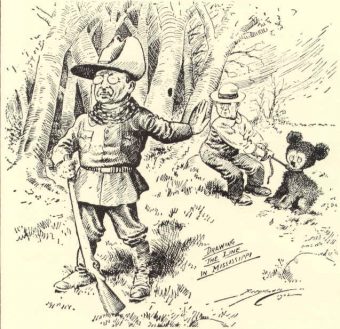
Beyond depicting Roosevelt refusing to harm the animal, the words, Drawing the Line in Mississippi, are sprawled in the cartoon. This is believed to have a double meaning, representing Roosevelt’s views on hunting and his loathing of the lynchings that were occurring in Mississippi and elsewhere in the South. (Unlike many of his era, Roosevelt was a strong supporter of black American rights, stating, “…the only wise and honorable and Christian thing to do is to treat each black man and each white man strictly on his merits as a man, giving him no more and no less than he shows himself worthy to have.”)
Among the millions of Americans who read of the incident, and particularly among those who saw this cartoon, was a couple from Brooklyn, New York, Morris and Rose Michtom. Morris was a Jewish immigrant who some 19 years before had fled the Russian pogroms, arriving in the United States with pretty much nothing but the clothes on his back as a teenager. At the time of Roosevelt’s bear hunting incident, Morris and his wife owned a small penny-item store, selling candy, small home-made toys and other such items.
When Morris saw Berryman’s cartoon, he suggested to Rose that she use her sewing talents to design and build a stuffed bear to honor the event. (Rose often made small children’s toys this way to sell in the shop.) The next day they displayed the bear in their store window and called it “Teddy’s bear,” resulting in many customers asking to buy the bear.
Detecting that there might be customer interest potentially beyond a handful of bears, they decided they probably needed the president’s permission if they wanted to mass-market the bears with that name. Thus, they sent the original bear to Teddy Roosevelt as a gift for his children and asked if he would allow them the continued usage of the name “Teddy’s Bear” (eventually to become “Teddy Bear”). Not thinking there was any harm, nor even that there would be much of a market for such a thing, the President agreed.
Popularity of teddy bears exceeded even the Michtom’s wildest expectations. Sales were such that they soon left their candy store behind to begin selling the bears throughout the United States and then later the world. Further expansion happened in 1907 when they opened the Ideal Novelty and Toy Company, which rapidly grew beyond selling stuffed bears and, shortly after WWII, became the largest doll making company in the United States for a time. More recently, they are known for creating the game Mouse Trap and introducing the Rubik’s Cube to America.
Interestingly enough, the stuffed bear was also independently created around the same time in Germany by the Steiff company. Margaret Steiff relied on her sewing skills to provide for her family. She started off by sewing stuffed elephants and then eventually added other animals to her collection of sellable goods. When her son designed a teddy bear based on the real life mammal he had recently seen at the zoo, his mom added bears to the collection, although with no knowledge of the growing popularity of that same item in the United States.
The bears made their debut to the greater public at a toy show in Leipzig, Germany. The lovable bear caught the attention of an American toy buyer who bought 3,000 of Steiff’s bears. Although Steiff bears wouldn’t become known as teddy bears until 1906, their early success started the international teddy bear craze. Like the Michtom’s, the Steiff Company started mass producing teddy bears and remains successful to this day designing and selling plush toys and collectibles.
If you liked this article, you might also enjoy our new popular podcast, The BrainFood Show (iTunes, Spotify, Google Play Music, Feed), as well as:
- In Which Teddy Roosevelt Makes Men Everywhere Feel a Little Less Manly
- How Did the Pet Rock Fad Start?
- Billion Dollar Babies: The History of Ty Beanie Babies
- The Surprisingly Long History of Nintendo
- From a Handmade Present for the Creator’s Daughter to a Multi-Billion Dollar Industry- The Story of the Troll Doll
Bonus Facts:
- In 1963 then president of Ideal Toy Company, Benjamin Michtom, decided that for the 60th anniversary of the Teddy Bear, it would be fun to take one of the first bears and have Teddy Roosevelt’s daughter pose with it. She refused, demonstrating her iconic wit even in her old age by stating, “What does a 79-year-old doll want with a 60-year-old bear?” Ultimately the photo-shoot was done with some of Teddy Roosevelt’s great-grand children, who were allowed to keep the bear for a time, so long as it was agreed that they’d donate it to the Smithsonian Institution, which they did in January of 1964. That bear is now part of the Smithsonian’s political history collection.
- When Roosevelt’s wife Alice died of undiagnosed kidney failure shortly after giving birth to their daughter Alice, and on the same day and in the same house as his mother died of typhoid fever 11 hours earlier, he simply put a giant X in his journal and wrote one sentence under it: “The light has gone out of my life.” From that day forward, Roosevelt almost never spoke of Alice or mentioned her name. He also didn’t like people mentioning her in his presence. On top of that, he rarely called his daughter by that name, giving her the nickname “Baby Lee”.
- Roosevelt’s daughter Alice was known for her quick wit, constant rule breaking, and “unladylike” habits of smoking, gambling, promiscuity, late night parties, and keeping a pet snake. Roosevelt once commented on his daughter’s frequent practice of interrupting state meetings to speak with him, saying “I can either run the country or I can attend to Alice, but I cannot possibly do both.”
- When the Roosevelt’s moved out of the White House, Alice Roosevelt buried a voodoo doll of the new President’s wife, Nellie Taft, in the front yard. Alice’s lone child, Paulina Longworth, was actually not from her husband, Nick Longworth, but the daughter of Senator William Borah who she had a long lasting affair with. Nick Longworth himself may have had children by women not Alice, as he was known to have had numerous affairs throughout their marriage, which had become an unhappy one after Alice had campaigned against him.
- Roosevelt was shot by saloon keeper John Schrank on October 14, 1912. His life was saved thanks to a steel eyeglass case and his 50 page speech he was carrying in his jacket, both of which the bullet had to pass through. He gave his speech anyway. (Yep.) His decision to go ahead with his speech, rather than seek medical aid immediately, was from concluding that because he was not coughing up blood, the bullet must not have penetrated that deeply into his chest. His opening line for the speech was, “Ladies and gentlemen, I don’t know whether you fully understand that I have just been shot; but it takes more than that to kill a Bull Moose.” X-rays later showed that the bullet had lodged 3 inches into his chest and was embedded in his ample chest muscle.
- In a display of classic gentlemanly honorable behavior rarely demonstrated by politicians today, during the week Roosevelt spent in the hospital after being shot, the other two Presidential candidates stopped their campaigns until he was released from the hospital and would be capable of campaigning himself. This was even more significant as there were just two weeks left until the election.
- During the 1904 presidential election, Roosevelt chose the teddy bear as the mascot for the Republican Party where it was used as the primary marketing tool for his campaign.
- Although known for his love of hunting, President Theodore Roosevelt made tremendous strides for wildlife preservation by protecting 230 million acres of public land from disturbance to ensure future generations could enjoy earth’s natural beauty. He created the United States Forest Service and established 150 national forests, 51 federal bird reserves, 5 national game reserves, 5 national parks, and 18 national monuments. When it came to wildlife preservation, Roosevelt was known as the first conservationist president who did more to protect the environment than perhaps any other president. He stated of this, “We have become great because of the lavish use of our resources. But the time has come to inquire seriously what will happen when our forests are gone, when the coal, the iron, the oil, and the gas are exhausted, when the soils have still further impoverished and washed into the streams, polluting the rivers, denuding the fields and obstructing navigation.”
- Roosevelt’s last name was commonly mispronounced even in his own day. He was even once publicly criticized for “mispronouncing” his own last name by Mr. Richard E. Mayne who was the chairman of the Department of Reading and Speech Culture for the New York State Teachers Association. Mayne felt Roosevelt was “perpetuating a practice against which are set the principles of usage…” by pronouncing his name Rose-uh-velt rather than using common English pronunciation to pronounce it as it’s spelled. As a response to Mr. Mayne, Roosevelt explained that his name is from his Dutch ancestry and so is pronounced as the Dutch would have. Specifically, in Dutch the double “o” makes a long “o” sound, thus should be pronounced “Rose” rather than “Roos”. And, indeed “roos” in Dutch means “rose”.
- Theodore Roosevelt was the fifth cousin of future President Franklin Delano Roosevelt. He was also the uncle of Franklin D. Roosevelt’s wife, Eleanor Roosevelt, who was Teddy’s brother Elliott’s daughter.
- Most of the characters and names in Winnie the Pooh were based on creator A.A. Milne’s son’s toys and stuffed animals with the exception of Owl, Rabbit, and Gopher. The character of Christopher Robin himself was based on Milne’s son Christopher Robin Milne. Christopher Robin Milne’s toy teddy bear, who Winnie the Pooh was created after, is currently on display in the New York Public Library. He named his teddy bear Winnie after a Canadian black bear he saw at the Zoo in London. The real life black bear was in turn named after the hometown of the person who captured the bear, Lieutenant Harry Colebourn, who was from Winnipeg, Manitoba. The bear ended up in the London Zoo after Colebourn was sent to England and then to France during WWI. When he was sent to France, he was unable to bring the bear so gave it to the London Zoo temporarily and later decided to make it a permanent donation after the bear became one of the Zoo’s top draws. The “Pooh” part of the name was supposedly after a black swan that Christopher Robin Milne saw while on holiday. A black swan named Pooh also appears in the Winnie-the-Pooh series.
Expand for References





